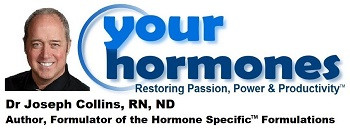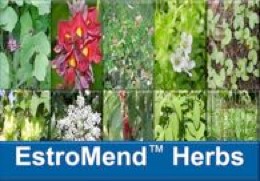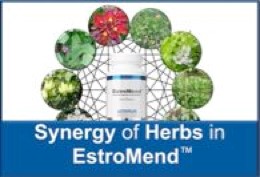
EstroMend™ contains non-estrogenic herbs that relieve hot flashes, night sweats, vaginal dryness, mood swings and memory problems. It promotes healthy mood, sleep, sexual function, memory and heart health without increasing estrogen risks. Take the Questionnaire to determine which product you may need for your hormone imbalance.
EstroMend™ is the only all natural formulation designed to address the full range of symptoms associated with decreased estrogen function. A synergistic combination of isoflavones, phytoestrogens & other herbs to naturally support optimal estrogen function.
Promotes healthy estrogen metabolism including 2-hydroxylation which may protect estrogen sensitive tissues.*
Promotes healthy function of bone, heart, brain, breasts, vagina and other estrogen sensitive tissues.*
Relieves many of the physical and psychological symptoms of menopause, such as hot flushes/night sweats, irritability, sleep disturbances, vaginal symptoms, mood swings & memory problems.*
May use without estrogen, or with bioidentical estrogen to support healthy estrogen function
How is EstroMend™ used?
EstroMend™ is used by healthcare professionals to decrease symptoms of estrogen deficiency without having to increase estrogen levels. EstroMend™ may be used instead of estrogen replacement therapy or it may be used with estrogen replacement therapy (ERT), to improve the safety and effectiveness of ERT. EstroMend™ improves patients with many conditions including:
Patients who do not want to use Estrogen Replacement Therapy (ERT) - because of personal or family history of estrogen sensitive cancer. Use EstroMend™ to decrease or eliminate symptoms without ERT.
Patients who are on ERT who still have symptoms - even when lab tests confirm optimal estradiol levels.
Patients on ERT who want to decrease side effects & risks associated with ERT - such as breast discomfort, other symptoms of estrogen sensitivity or concerns about increased risk of estrogen sensitive cancers
Patients who want to wean off of ERT should start EstroMend™ a month before weaning off of ERT to successfully wean off of ERT without symptoms of estrogen withdrawal.
Akhondzadeh S, Noroozian M, Mohammadi M, Ohadinia S, Jamshidi AH, Khani M. Salvia officinalis extract in the treatment of patients with mild to moderate Alzheimer's disease: a double blind, randomized and placebo-controlled trial. J Clin Pharm Ther. 2003 Feb;28(1):53-9.
Antiproliferative and cytotoxic effects of prenylated flavonoids from hops (Humulus lupulus) in human cancer cell lines.Food Chem Toxicol. 1999 Apr;37(4):271-85.
Bagchi D, Sen CK, Bagchi M, Atalay M. Anti-angiogenic, antioxidant, and anti-carcinogenic properties of a novel anthocyanin-rich berry extract formula. Biochemistry (Mosc). 2004 Jan;69(1):75-80.
Beuscher, N. Cimicifuga racemosa L.- Black Cohosh. Quarterly Review of Natural Medicine Spring 1996.
Blumenthal M. The Complete German Commission E Monograph: Therapeutic Guide to Herbal Medicines. Austin, TX: American Botanical Council; 1998:147.
Chen WJ, Lin JK. Mechanisms of cancer chemoprevention by hop bitter acids (beer aroma) through induction of apoptosis mediated by Fas and caspase cascades.J Agric Food Chem. 2004 Jan 14;52(1):55-64.
Chiu PY, Mak DH, Poon MK, Ko KM. In vivo antioxidant action of a lignan-enriched extract of Schisandra fruit and an anthraquinone-containing extract of Polygonum root in comparison with schisandrin B and emodin. Planta Med. 2002 Nov;68(11):951-6.
Choy YM, Leung KN, Cho CS, Wong CK, Pang PK. Immunopharmacological studies of low molecular weight polysaccharide from Angelica sinensis. Am J Chin Med. 1994;22(2):137-45.
Collins, JJ. 2002. Discover Your Menopause Type. Prima Publishing Rocklin, CA
Daniela T. [Salvia officinalis l. I. Botanic characteristics, composition, use and cultivation] Cesk Farm. 1993 Jun;42(3):111-6. Slovak.
De Leo V, Lanzetta D, Cazzavacca R, Morgante G. [Treatment of neurovegetative menopausal symptoms with a phytotherapeutic agent] Minerva Ginecol. 1998 May;50(5):207-11. Italian.
Duke JA. CRC Handbook of Medicinal Herbs. Boca Raton, FL: CRC Press, 1985
Duker EM, Kopanski L, Jarry H, Wuttke E. Effects of extracts from Cimicifuga racemosa on gonadotropin release in menopausal women and ovarectomized rats. Planta Medica 1991;57:420-4.
Goetz P. Treatment of hot flashes due to ovarian insufficiency using a hops extract (Humulus lupus). Rev Phytotherapie Pratique 1990;4:13-15. [Article in French]
Hirata JD, Swiersz LM, Zell B, Small R, Ettinger B. Does dong quai have estrogenic effects in postmenopausal women? A double-blind, placebo-controlled trial. Fertil Steril. 1997 Dec;68(6):981-6.
Hohmann J, Zupko I, Redei D, Csanyi M, Falkay G, Mathe I, Janicsak G. Protective effects of the aerial parts of Salvia officinalis, Melissa Officinalis and Lavandula angustifolia and their constituents against enzyme-dependent and enzyme-independent lipid peroxidation. Planta Med. 1999 Aug;65(6):576-8.
Kar A, Panda S, Bharti S. Relative efficacy of three medicinal plant extracts in the alteration of thyroid hormone concentrations in male mice.J Ethnopharmacol. 2002 Jul;81(2):281-5.
Kavvadias D, Monschein V, Sand P, Riederer P, Schreier P. Constituents of sage (Salvia officinalis) with in vitro affinity to human brain benzodiazepine receptor. Planta Med. 2003 Feb;69(2):113-7.
Knight DC, Eden JA. A review of the clinical effects of phytoestrogens. Obstet Gynecol 1996;87:897-904.
Kruse SO, Lohning A, Pauli GF, et al. Fukiic and piscidic acid esters from the rhizome of Cimicifuga racemosa and the in vitro estrogenic activity of fukinolic acid. Planta Med 1999;65:763-764.
Li PC, Poon KT, Ko KM. Schisandra chinensis-dependent myocardial protective action of sheng-mai-san in rats. Am J Chin Med. 1996;24(3-4):255-62.
Lieberman S. A review of the effectiveness of Cimicifuga racemosa (black cohosh) for the symptoms of menopause. Journal of Womens Health 1998;7:525-9.
Liu J, Burdette JE, Xu H, Gu C, van Breemen RB, Bhat KP, Booth N, Constantinou AI, Pezzuto JM, Fong HH, Farnsworth NR, Bolton JL. Evaluation of estrogenic activity of plant extracts for the potential treatment of menopausal symptoms. J Agric Food Chem. 2001 May;49(5):2472-9.
Liu J, Burdette JE, Xu H, Gu C, van Breemen RB, Bhat KP, Booth N, Constantinou AI, Pezzuto JM, Fong HH, Farnsworth NR, Bolton JL. Evaluation of estrogenic activity of plant extracts for the potential treatment of menopausal symptoms. J Agric Food Chem. 2001 May;49(5):2472-9.
Lu H, Liu GT. Anti-oxidant activity of dibenzocyclooctene lignans isolated from Schisandraceae. Planta Med. 1992 Aug;58(4):311-3.
Mahady GB, Fong HHS, Farnsworth NR. Rhizoma Cimicifuga racemosae. In: WHO Monographs on Selected Medicinal Plants, Volume II. Geneva, Switzerland: World Health Organization; 2002.
Mills SY. The Dictionary of Modern Herbalism. Wellingborough, NY: Thorsons Publishing Group, 1985.
Miranda CL, Stevens JF, Helmrich A, Henderson MC, Rodriguez RJ, Yang YH, Deinzer ML, Barnes DW, Buhler DR. Antiproliferative and cytotoxic effects of prenylated flavonoids from hops (Humulus lupulus) in human cancer cell lines. Food Chem Toxicol. 1999 Apr;37(4):271-85.
Miranda CL, Stevens JF, Helmrich A, Henderson MC, Rodriguez RJ, Yang YH, Deinzer ML, Barnes DW, Buhler DR.
Nathan PJ, Clarke J, Lloyd J, Hutchison CW, Downey L, Stough C. The acute effects of an extract of Bacopa monniera (Brahmi) on cognitive function in healthy normal subjects.Hum Psychopharmacol. 2001 Jun;16(4):345-351
Nikolic D, Li Y, Chadwick LR, Grubjesic S, Schwab P, Metz P, van Breemen RB. Metabolism of 8-prenylnaringenin, a potent phytoestrogen from hops (Humulus lupulus), by human liver microsomes. Drug Metab Dispos. 2004 Feb;32(2):272-9.
Nikolic D, Li Y, Chadwick LR, Grubjesic S, Schwab P, Metz P, van Breemen RB. Metabolism of 8-prenylnaringenin, a potent phytoestrogen from hops (Humulus lupulus), by human liver microsomesDrug Metab Dispos. 2004 Feb;32(2):272-9.
Nishiyama N, Wang YL, Saito H. Beneficial effects of S-113m, a novel herbal prescription, on learning impairment model in mice. Biol Pharm Bull. 1995 Nov;18(11):1498-503.
Opletal L, Krenkova M, Havlickova P. [Phytotherapeutic aspects of diseases of the circulatory system. 7. Schisandra chinensis (Turcz.) Baill.): its composition and biological activity] Ceska Slov Farm. 2001 Jul;50(4):173-80. Review. Czech.
Opletal L, Krenkova M, Havlickova P. [Phytotherapeutic aspects of diseases of the circulatory system. 8. Chinese magnolia (Schisandra chinensis (Turcz.) Baill.): production of the drugs and their evaluation, therapeutic and dietary preparations] Ceska Slov Farm. 2001 Sep;50(5):219-24. Czech.
Ozaki Y. Antiinflammatory effect of tetramethylpyrazine and ferulic acid. Chem Pharm Bull (Tokyo). 1992 Apr;40(4):954-6.
Pan SY, Han YF, Carlier PR, Pang YP, Mak DH, Lam BY, Ko KM. Schisandrin B protects against tacrine- and bis(7)-tacrine-induced hepatotoxicity and enhances cognitive function in mice. Planta Med. 2002 Mar;68(3):217-20.
Perry EK, Pickering AT, Wang WW, Houghton PJ, Perry NS. Medicinal plants and Alzheimer's disease: from ethnobotany to phytotherapy. J Pharm Pharmacol. 1999 May;51(5):527-34.
Rai D, Bhatia G, Palit G, Pal R, Singh S, Singh HK. Adaptogenic effect of Bacopa monniera (Brahmi).Pharmacol Biochem Behav. 2003 Jul;75(4):823-30.
Roodenrys S, Booth D, Bulzomi S, Phipps A, Micallef C, Smoker J. Chronic effects of Brahmi (Bacopa monnieri) on human memory. Neuropsychopharmacology. 2002 Aug;27(2):279-81.
Russo A, Izzo AA, Borrelli F, Renis M, Vanella A. Free radical scavenging capacity and protective effect of Bacopa monniera L. on DNA damage. Phytother Res. 2003 Sep;17(8):870-5.
Rutherford DM, Nielsen MP, Hansen SK, Witt MR, Bergendorff O, Sterner O. Isolation and identification from Salvia officinalis of two diterpenes which inhibit t-butylbicyclophosphoro[35S]thionate binding to chloride channel of rat cerebrocortical membranes in vitro. Neurosci Lett. 1992 Feb 3;135(2):224-6.
Shang P, Qian AR, Yang TH, Jia M, Mei QB, Cho CH, Zhao WM, Chen ZN. Experimental study of anti-tumor effects of polysaccharides from Angelica sinensis. World J Gastroenterol. 2003 Sep;9(9):1963-7.
Stevens JF, Miranda CL, Wolthers KR, Schimerlik M, Deinzer ML, Buhler DR. Identification and in vitro biological activities of hop proanthocyanidins: inhibition of nNOS activity and scavenging of reactive nitrogen species. J Agric Food Chem. 2002 Jun 5;50(12):3435-43.
Stough C, Lloyd J, Clarke J, Downey LA, Hutchison CW, Rodgers T, Nathan PJ. The chronic effects of an extract of Bacopa monniera (Brahmi) on cognitive function in healthy human subjects. Psychopharmacology (Berl). 2001 Aug;156(4):481-4.
Sun J, Chu YF, Wu X, Liu RH. Antioxidant and antiproliferative activities of common fruits. J Agric Food Chem. 2002 Dec 4;50(25):7449-54.
Togel B, Greve B, Raulin C. Current therapeutic strategies for hyperhidrosis: a review. European Journal of Dermatology. Volume 12, Number 3, 219-23, Mai - Juin 2002, Revues
Tripathi YB, Chaurasia S, Tripathi E, Upadhyay A, Dubey GP. Bacopa monniera Linn. as an antioxidant: mechanism of action. Indian J Exp Biol. 1996 Jun;34(6):523-6.
Vohora D, Pal SN, Pillai KK. Protection from phenytoin-induced cognitive deficit by Bacopa monniera, a reputed Indian nootropic plant.J Ethnopharmacol. 2000 Aug;71(3):383-90.
Wang BH, Ouyang JP, Liu YM, Wei L, Yang JW. [Protective effect of Angelica on ECV(304) from injury induced by hyperlipidemic serum in vitro] Sheng Li Xue Bao. 2001 Jun;53(3):240-3. Chinese.
Wang M, Kikuzaki H, Zhu N, Sang S, Nakatani N, Ho CT. Isolation and structural elucidation of two new glycosides from sage (Salvia officinalis L.). J Agric Food Chem. 2000 Feb;48(2):235-8.
Wilasrusmee C, Siddiqui J, Bruch D, Wilasrusmee S, Kittur S, Kittur DS. In vitro immunomodulatory effects of herbal products. Am Surg. 2002 Oct;68(10):860-4.
Winterhoff H, Butterweck V, Jarry H, Wuttke, W. Pharmacologic and clinical studies using Cimicifuga racemosa in climacteric complaints. Wien Med Wochenschr 2002;152:360-363. [Article in German]
Yan X, Murphy BT, Hammond GB, Vinson JA, Neto CC. Antioxidant activities and antitumor screening of extracts from cranberry fruit (Vaccinium macrocarpon). J Agric Food Chem. 2002 Oct 9;50(21):5844-9.
Yang Q, Populo SM, Zhang J, Yang G, Kodama H. Effect of Angelica sinensis on the proliferation of human bone cells. Clin Chim Acta. 2002 Oct;324(1-2):89-97.
Ye YN, So HL, Liu ES, Shin VY, Cho CH. Effect of polysaccharides from Angelica sinensis on gastric ulcer healing. Life Sci. 2003 Jan 10;72(8):925-32.
Zhu DP. Dong quai. Am J Chin Med. 1987;15(3-4):117-25.







